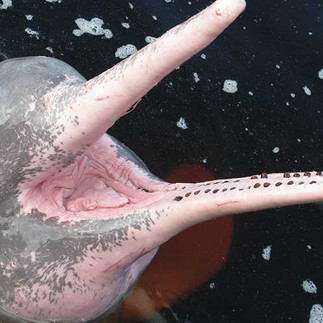Fauna In Leticia Amazon(Pink Dolphin)
- expeditions george of the jungle
- Dec 3, 2022
- 3 min read

Amazon fauna
The Amazon is home to the greatest biodiversity on the planet. This is not quite surprising considering that it is the largest tropical forest on the planet, with an area of 5,500,000 km². The abundance of sunlight and water are some of the reasons why this area is so biologically rich. Even though this biodiversity is spread over such a large area, each portion of the Amazon is still home to an incredible number of plant and animal species.
Pink dolphin
Familia: Iniidae
The pink dolphin is one of the emblematic species of the Amazon. It is also called Boto or Bufeo and is the largest freshwater dolphin. Amazonian tribes tell stories of these animals saving people from drowning and taking them to the shore because they are friendly and noble. Its scientific name is Inia geoffrensis and it belongs to the genus Inea, part of the Platanistoidea family. The pink dolphin is a cetacean that is nothing like the common sea dolphin, on the contrary, it has unique characteristics to survive in its habitat.
There are legends and myths about the pink Amazon river dolphin. According to a myth, the pink dolphin was originally an indigenous warrior who was transformed by a god envious of his masculinity into a dolphin. And, during the summer festivals, the dolphin transforms back into a human to go to the villages and seduce the girls.
Pink Dolphin Diet
It feeds on more than 50 different species of fish, sometimes eating crabs, molluscs and freshwater turtles. Dolphins have a flexible neck, which can be moved from side to side, making them ideal for navigating through flooded forests.
Behaviour
It is a solitary cetacean and rarely groups with a few other members. It is very common to see mothers with their young calves. A large number of pink dolphins can be seen in areas where food is abundant. They are not very playful, aggressive or acrobats like other species of dolphins, but they have been seen repeatedly living with fish, turtles and other marine animals, holding fishermen’s nets and displaying other behaviours that are not very shy. Rarely swims fast reaching speeds of up to 20 km/h, but commonly swims at 1.5 or 3.2 km/h
Reproduction
Males reach sexual maturity when they reach 1.80 or 2 meters in length and females in less time when they reach 1.60 or 1.75 meters in length. Due to various bite wounds and abrasions that can be seen on the fins of the males, they are said to compete in breeding seasons to determine the winner who will have the right to mate with the female.
The gestation period lasts 9-12 months and they only have one calf. The birth occurs in the flood season and the newborn has an initial weight of 80 kg. The Calf is breastfed during a year and the interval between births is from 15 to 36 months.
What is the reason why the skin of the pink dolphin turns pink?
The reason why they are pink is unknown, it could be an adaptation to life in the river, the temperature or the presence of capillaries near the surface of the skin. Although, the most successful theory is that the pink coloration is acquired over time. At birth and in their youth they are gray, in adolescence light gray and in adulthood they turn pink as a result of the wear of their skin. Also, it is said that most of the females are gray and the males are pink due to the scars.
Threats to the pink dolphin
As natural predators we find the black caiman, the bull shark, the jaguar and the anaconda. On the other hand, man has been responsible for the decline in the number of pink dolphins. This is due to various factors, including the massive destruction of the Amazon rainforest due to deforestation and pollution, accidental capture and cruel killing by fishermen, since this species of dolphin can break fishing nets causing them to lose all the work done by the workers.
There are currently several aquariums where these dolphins are kept in captivity. Although it was not easy to incorporate them and make them survive for a long time, the new generations are very well adapted and manage to live for many years.









Comments